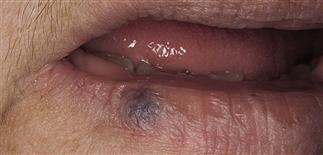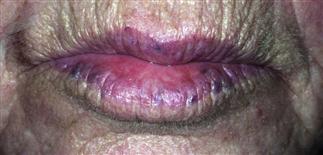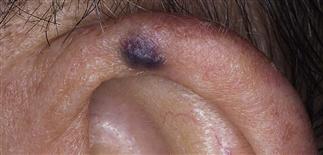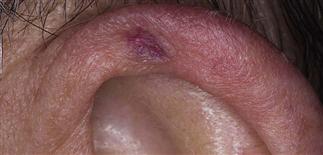144
Venous lake

Venous lakes can mimic melanoma; however, they lose their color when compressed. The lower lip is a common location for a venous lake.

Venous lakes are more common on sun-exposed areas such as the lower lip. Multiple venous lakes can occur.

Raised venous lakes can be itchy and sore, and can easily bleed when traumatized.

Lesions may occur on the ear.
DESCRIPTION
Small, blanchable, dark-blue to purple papule resulting from a dilated vein.
HISTORY
• Common on sun-exposed skin of elderly patients, especially white men. • Acquired sun damage and subsequent loss of dermal elasticity (solar elastosis) cause venous lakes. • They persist and increase in size with time.
PHYSICAL FINDINGS
• Asymptomatic, dark-blue to purple, soft papule (2–10 mm) that blanches with pressure. • Multiple lesions may be present on the mucosal surface of the lip, especially the lower lateral vermilion border. • Lesions may be found on the ears; itchy and sore lesions suggest thrombosis. • Traumatized lesions bleed easily and form a hemorrhagic crust.
TREATMENT
• Reassurance. • Traumatized or cosmetically concerning lesions and lesions that interfere with eating or speaking should be treated; recurrence is common. • After anesthetizing with local or regional anesthesia, the venous lake is unroofed with iris scissors and cauterized. Lasers are also effective.







